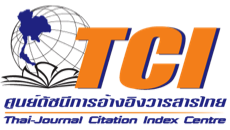การพัฒนามโนทัศน์ทางวิทยาศาสตร์ เรื่อง การแบ่งเซลล์และความพึงพอใจของนักเรียน ชั้นมัธยมศึกษาปีที่ 4 ด้วยการจัดการเรียนรู้ตามแนวทางสะเต็มศึกษา ด้วยวัฏจักรการเรียนรู้ 6 ขั้น (The Development of Grade 10th Students’ Scientific Concepts of Cell Division and Satisfaction through Science, Technology, Engineering and Mathematics (STEM) Education by 6E Learning Cycle)
คำสำคัญ:
มโนทัศน์ทางวิทยาศาสตร์, การแบ่งเซลล์, สะเต็มศึกษา, วัฏจักรการเรียนรู้ 6 ขั้นบทคัดย่อ
วัตถุประสงค์ของการวิจัยในครั้งนี้เพื่อศึกษามโนทัศน์ทางวิทยาศาสตร์ก่อนเรียนและหลังเรียน และพัฒนาความเข้าใจมโนทัศน์ทางวิทยาศาสตร์เรื่อง การแบ่งเซลล์ และศึกษาความพึงพอใจของนักเรียน ชั้นมัธยมศึกษาปีที่ 4 ด้วยการจัดการเรียนรู้ตามแนวทางสะเต็มศึกษาด้วยวัฏจักรการเรียนรู้ 6 ขั้น เครื่องมือที่ใช้ประกอบด้วย 1) แผนการจัดการเรียนรู้เรื่อง การแบ่งเซลล์ด้วยการจัดการเรียนรู้ตามแนวทาง สะเต็มศึกษาด้วยวัฏจักรการเรียนรู้ 6 ขั้น 2) แบบวัดมโนทัศน์ทางวิทยาศาสตร์เรื่อง การแบ่งเซลล์ 3) แบบสัมภาษณ์นักเรียนและ 4) แบบสำรวจความพึงพอใจของนักเรียน ผลการวิจัยพบว่า การจัดการเรียนรู้ตามแนวทางสะเต็มศึกษาด้วยวัฏจักรการเรียนรู้ 6 ขั้น สามารถพัฒนามโนทัศน์เรื่องการแบ่งเซลล์ของนักเรียนได้ โดยก่อนการจัดการเรียนรู้นักเรียนส่วนใหญ่มีมโนทัศน์ ที่คลาดเคลื่อนจากมโนทัศน์ทางวิทยาศาสตร์ หลังการจัดการเรียนรู้ตามแนวทางสะเต็มศึกษาด้วยวัฏจักร การเรียนรู้ 6 ขั้น พบว่า นักเรียนส่วนใหญ่มีมโนทัศน์หลังเรียนสอดคล้องกับมโนทัศน์ทางวิทยาศาสตร์ เพิ่มมากขึ้นและนักเรียนมีความพึงพอใจต่อการจัดการเรียนรู้ตามแนวทางสะเต็มศึกษาด้วยวัฏจักรการเรียนรู้ 6 ขั้นเรื่อง การแบ่งเซลล์ในระดับมาก
เอกสารอ้างอิง
Solving Ability and Instructional Satisfaction of Grade 11 Students. Master of Education in Teaching Science and Mathematics Prince of Songkla University. (in Thai)
Burk, B. N. (2014). THE ITEEA 6E learning by Design™ model: Maximizing informed design and inquiry in the integrative STEM classroom. Technology and Engineering Teacher, 73(6): 14–19.
Bybee, R. W. (2010). Advancing STEM Education: A 2020 Vision. Technology and Engineering Teacher, 70: 30-35.
Chocchai, L. Tanak, A. and Saksoong, P. (2014). “The Development of 7th Grade Students’ Conception about Cells by Model-based Learning Activities” In Proceeding of The 52th Kasetsart University Annual Conference. Bangkok. (in Thai)
Dikmenli, M. (2010). “Misconceptions of cell division held by student teachers in biology: A drawing analysis”. Scientific Research and Essay 5(2): 235-247.
Kampeewat, W. (2013). A Survey on the Secondary School Student’s Satisfaction towards the School Management of the Secondary Educational Service Area Office 1 and 2 (Bangkok Area). Master of Science (Applied Statistics and Information Technology) National Institute of Development Administration. (in Thai)
Kaniawati, D. and Suryadi (2016). “Integration of STEM Education In Learning Cycle 6E To Improve Problem Solving Skills on Direct”. International Conference on Mathematics, Science, and Education Current Electricity. [Online].
Retrieved December 15, 2020, from:
file:///C:/Users/Acer/Desktop/conceptual%20change/13389-Article%20Text-27308-1-10-20170315.pdf
Lantz, H. B. (2009). Science, Technology, Engineering, and Mathematics (STEM) Education: What form? What function?. [Online]. Retrieved December 15, 2020,
from: http://www.currtechintegrations.com/pdf/STEMEducationArticle.pdf
Onpuy, W and Treewong, P. (2020). “Development of a Conceptual Teaching Model (STEM)
to Improve Students' Analytical Thinking Skills in Mathematics for Preschool Children”. Phetchabun Rajabhat Journal 22(1): 77-86. (in Thai)
Oztas, H., Ozay, E and Oztas, F., 2003. “Teaching cell division to secondary school students: An investigation of difficulties experienced by Turkish teachers”. Journal Biology Education. 38, (1): 13-15.
Phanchan, M. (2017). The Development and Retention of Grade 10 Student’s Achievement in Biology on Cell of Living Organism by Scientific Inquiry. Master Degree of Science Thesis Program in Science Education Graduate School Ubon Ratchathani University. (in Thai)
Prasarnned, P. and Sumranwanich, S. (2013). “Grade 10 student’ mental representation about cell division through slow-motion”. Journal of Education Graduate Studies Research 8(2): 91–98. (in Thai)
Saenpan, W. (2010). Knowledge of Science and Process of Learning Design in Science. Bangkok: Ramkhamhaeng University Press. (in Thai)
Smith, M. U. (1991). “Teaching cell division: Student difficulties and teaching recommendations”. Journal of College Science Teaching, 21(1): 28–33.
Smith, J. & Karr-Kidwell, P. (2000). The interdisciplinary curriculum: A literary review and a manual for administrators and teachers. Retrieved from ERIC database.
Stohlmann, M. Moore, T. and Roehrig, G. (2012). “Consideration For Teaching Integrating STEM Education”. Journal of Pre-College Engineering Education Research (J-PEER). 2(1): 28-34.





